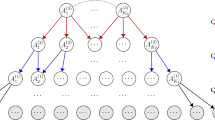Abstract
The Deterministic Input Noisy Output “AND” gate (DINA) model and the Deterministic Input Noisy Output “OR” gate (DINO) model are two popular cognitive diagnosis models (CDMs) for educational assessment. They represent different views on how the mastery of cognitive skills and the probability of a correct item response are related. Recently, however, Liu, Xu, and Ying demonstrated that the DINO model and the DINA model share a “dual” relation. This means that one model can be expressed in terms of the other, and which of the two models is fitted to a given data set is essentially irrelevant because the results are identical. In this article, a proof of the duality of the DINA model and the DINO model is presented that is tailored to the form and parameterization of general CDMs that have become the new theoretical standard in cognitively diagnostic modeling.
Similar content being viewed by others
References
CHIU, C.-Y., and KÖHN, H.-F. (2015a), “Consistency of Cluster Analysis for Cognitive Diagnosis: The DINO Model and the DINAModel Revisited,” Applied Psychological Measurement, 39, 465–479.
CHIU, C.-Y., and KO¨ HN, H.-F. (2015b), “The Reduced RUM as a Logit Model: Parameterization and Constraints,” Psychometrika, in press.
CHIU, C.-Y., DOUGLAS, J.A., and LI, X. (2009), “Cluster Analysis for Cognitive Diagnosis: Theory and Applications,” Psychometrika, 74, 633–665.
DE LA TORRE, J. (2011), “The Generalized DINA Model Framework,” Psychometrika, 76, 179–199.
DE LA TORRE, J., and LEE, Y.-S., (2013), “Evaluating the Wald Test for Item-Level Comparison of Saturated and Reduced Models in Cognitive Diagnosis,” Journal of Educational Measurement, 50, 355–373.
DECARLO, L.T. (2011), “On the Analysis of Fraction Subtraction Data: The DINAModel, Classification, Latent Class Sizes, and the Q-Matrix,” Applied Psychological Measurement, 35, 8–26.
DIBELLO, L.V., ROUSSOS, L.A., and STOUT, W. (2007), “Review of Cognitively Diagnostic Assessment and a Summary of Psychometric Models,” in Handbook of Statistics: Vol. 26. Psychometrics, eds. C.R. Rao and S. Sinharay, Amsterdam: North-Holland, pp. 979–1030.
HABERMAN, S.J., and VON DAVIER, M. (2007), “Some Notes on Models for Cognitively Based Skills Diagnosis,” in Handbook of Statistics: Vol. 26. Psychometrics, eds. C.R. Rao and S. Sinharay, Amsterdam: North-Holland, pp. 1031–1038.
HARTZ, S.M. (2002), “A Bayesian Framework for the Unified Model for Assessing Cognitive Abilities: Blending Theory with Practicality,” Doctoral dissertation, available from ProQuest Dissertations and Theses database (UMI No. 3044108).
HARTZ, S.M., and ROUSSOS, L.A. (2008), “The FusionModel for SkillDiagnosis: Blending Theory with Practicality,” Research Report No. RR-08-71, Princeton, NJ: Educational Testing Service.
HENSON, R.A., TEMPLIN, J.L., and WILLSE, J.T. (2009), “Defining a Family of Cognitive Diagnosis Models Using Log-Linear Models with Latent Variables,” Psychometrika, 74, 191–210.
JUNKER, B.W., and SIJTSMA, K. (2001), “Cognitive Assessment Models with Few Assumptions, and Connections with Nonparametric Item Response Theory,” Applied Psychological Measurement, 25, 258–272.
LEIGHTON, J., and GIERL, M. (2007), Cognitive Diagnostic Assessment for Education: Theory and Applications, Cambridge, UK: Cambridge University Press.
LIU, Y., XU, G., and YING, Z. (2011), “Learning Item-Attribute Relationship in Q-Matrix Based Diagnostic Classification Models,” Report: arXiv:1106.0721, New York City, NY: Columbia University, Department of Statistics. Retrieved from the website http://arxiv.org/pdf/1106.0721v1.pdf.
MACREADY, G.B., and DAYTON, C.M. (1977), “The Use of Probabilistic Models in the Assessment of Mastery,” Journal of Educational Statistics, 2, 99–120.
MARIS, E. (1999), “Estimating Multiple Classification Latent Class Models,” Psychometrika, 64, 187–212.
MARIS, E., and BECHGER, T. (2008), “Equivalent Diagnostic Classification Models,” Measurement, 7, 41–46.
PAPADIMITRIOU, C.H., and STEIGLITZ, K. (1998), Combinatorial Optimization: Algorithms and Complexity (2nd ed.), Mineola, NY: Dover.
ROBITZSCH, A., KIEFER, T., GEORGE, A.C., and UENLUE, A. (2016), CDM: Cognitive Diagnosis Modeling. R Package Version 3.1-14, Retrieved from the Comprehensive R Archive Network [CRAN] website http://CRAN.R-project.org/package=CDM.
RUPP, A.A., TEMPLIN, J.L., and HENSON, R.A. (2010), Diagnostic Measurement. Theory, Methods, and Applications, New York: Guilford.
TATSUOKA, K.K. (1983), “Rule-Space: An Approach for Dealing with Misconceptions Based on Item-Response Theory,” Journal of Educational Measurement, 20, 345–354.
TATSUOKA, K.K. (1985), “A Probabilistic Model for Diagnosing Misconception by the Pattern Classification Approach,” Journal of Educational Statistics, 10, 55–73.
TEMPLIN, J.L., and HENSON, R.A. (2006), “Measurement of Psychological Disorders Using Cognitive Diagnosis Models,” Psychological Methods, 11, 287–305.
VON DAVIER, M. (2005), “A General Diagnostic Model Applied to Language Testing Data,” Research Report No. RR-05-16, Princeton, NJ: Educational Testing Service.
VON DAVIER, M. (2008), “A General Diagnostic Model Applied to Language Testing Data,” British Journal of Mathematical and Statistical Psychology, 61, 287–301.
VON DAVIER, M. (2011), “Equivalency of the DINA Model and a Constrained General Diagnostic Model,” Research Report No. RR-11-37, Princeton, NJ: Educational Testing Service.
VON DAVIER, M. (2014), “The DINA Model as a Constrained General Diagnostic Model: Two Variants of a Model Equivalency,” British Journal of Mathematical and Statistical Psychology, 67, 49–71.
Author information
Authors and Affiliations
Corresponding author
Rights and permissions
About this article
Cite this article
Köhn, HF., Chiu, CY. A Proof of the Duality of the DINA Model and the DINO Model. J Classif 33, 171–184 (2016). https://doi.org/10.1007/s00357-016-9202-x
Published:
Issue Date:
DOI: https://doi.org/10.1007/s00357-016-9202-x




